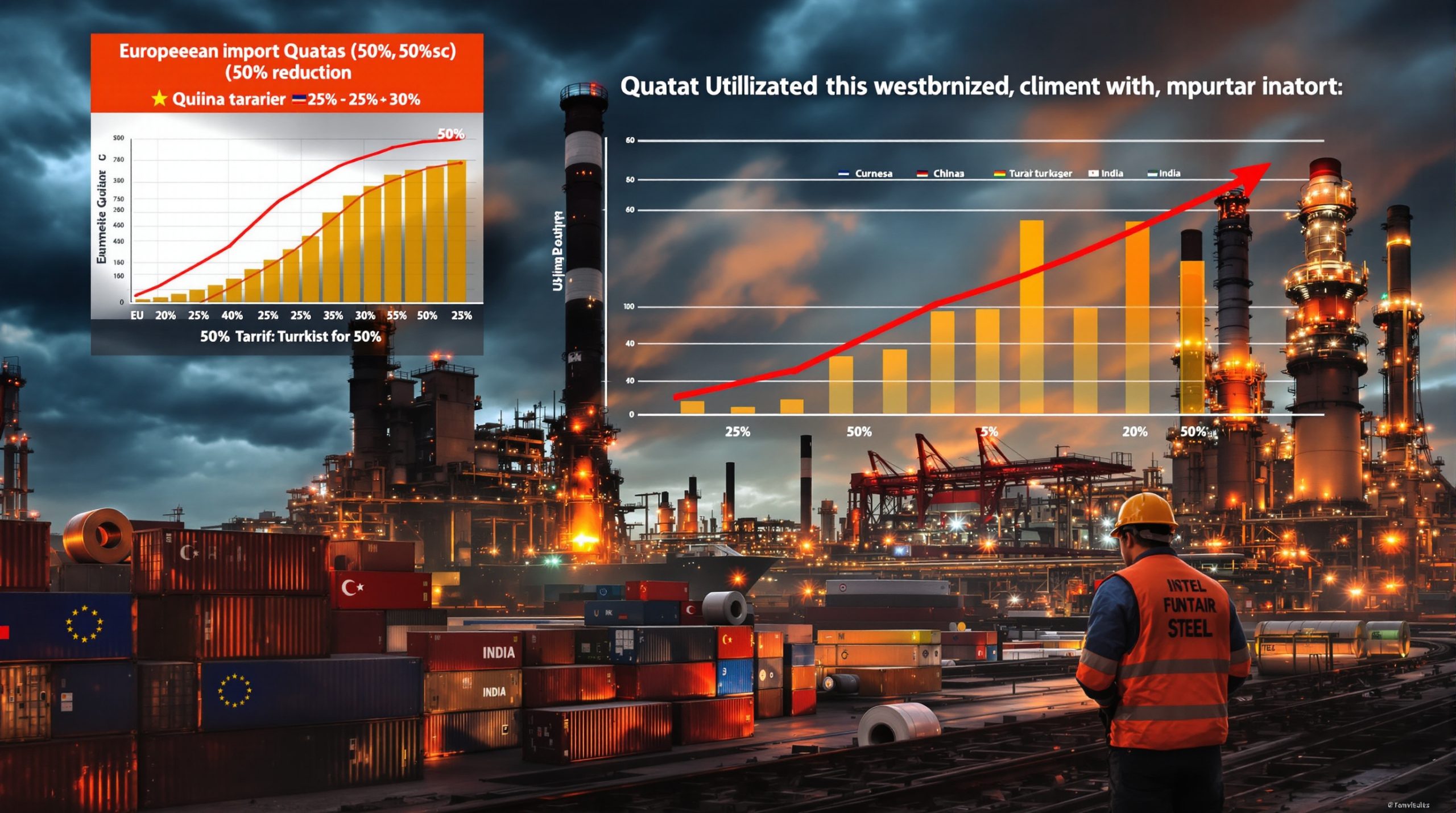What is Causing Pan Pacific Copper's 2.5% Production Reduction?
Pan Pacific Copper (PPC), Japan's largest copper supplier, has announced plans to reduce its refined copper production by 2.5% in the second half of the 2025/26 financial year compared to the same period last year. This strategic decision comes as part of the company's response to evolving market dynamics and operational considerations within the global copper industry.
The company plans to produce 287,400 metric tons of refined copper during the October 2025-March 2026 period, marking a notable reduction from previous output levels. This adjustment signals important shifts in both company strategy and broader market conditions affecting copper production worldwide.
Current Production Numbers and Reduction Details
PPC's decision to implement this production cut comes at a time when the global copper market is experiencing significant transitions. The planned output of 287,400 metric tons represents careful calibration of production capacity against current market realities.
The 2.5% year-over-year reduction specifically targets the second half of Japan's 2025/26 fiscal year, which runs from October through March. This timing is significant as it coincides with seasonal patterns in global copper demand and pricing cycles.
PPC operates through a distinctive business model where actual smelting and refining operations are outsourced to parent companies' facilities, allowing the company to focus on material procurement and sales activities. This arrangement provides flexibility in production planning while maintaining market presence.
PPC's Corporate Structure and Operational Model
Understanding PPC's corporate structure helps provide context for this production decision. The company's ownership is distributed among three major Japanese industrial entities:
- 47.8% owned by JX Advanced Metals
- 32.2% held by Mitsui Mining and Smelting
- 20% by Marubeni Corporation
This tripartite ownership structure creates a complex decision-making environment where multiple corporate strategies and priorities must be balanced. Each parent company brings different perspectives to production planning based on their broader business portfolios and market outlooks.
PPC's business model is distinguished by its focus on raw material procurement and refined metal sales, while outsourcing the actual smelting operations to its parent companies' facilities. This arrangement allows for coordinated production adjustments across multiple facilities while maintaining unified market engagement through PPC.
How Does This Reduction Impact Global Copper Markets?
The 2.5% reduction in PPC's output represents a significant development in the copper market, especially considering Japan's position as a major refined copper producer and PPC's role as the country's largest supplier. While seemingly modest in percentage terms, this production adjustment could have cascading effects through global supply chains.
Global copper markets remain sensitive to production changes from major suppliers, with even minor adjustments potentially influencing market sentiment and price dynamics. Current copper price predictions at $4.841 per pound reflects ongoing market assessments of supply-demand balances, with PPC's production cut potentially contributing to upward price pressure if other suppliers don't compensate with increased output.
Supply-Demand Implications
The production cut occurs against a backdrop of tightening global copper supply forecast. Mining output constraints, declining ore grades at major operations, and increasing competition for concentrate among smelters worldwide create a complex supply environment where even modest production adjustments carry significance.
Reduced Japanese copper exports to Asian markets may result from this production cut, potentially creating localized supply constraints for manufacturing hubs in South Korea, China, and Southeast Asia that rely on Japanese refined copper imports. This could accelerate copper sourcing diversification strategies across the region.
The reduction contributes to global refined copper supply constraints at a time when electrification trends, renewable energy development, and infrastructure modernization continue to drive surging copper demand. This supply-side adjustment, when combined with similar decisions by other major producers, could accelerate copper market tightening through 2026.
Market Pricing Effects
PPC's production cut may contribute to establishing stronger copper price floors by signaling disciplined supply management among major producers. When major suppliers demonstrate willingness to adjust production rather than maintaining output at all costs, market perception of supply discipline often strengthens.
The reduction could impact treatment and refining charges (TC/RCs) – the fees miners pay to smelters for processing copper concentrate into refined metal. Tighter concentrate supplies typically reduce these charges, affecting profitability calculations throughout the copper value chain.
Downstream industries dependent on copper inputs, including electrical equipment manufacturing, construction, and automotive production, may face procurement challenges if the production cut contributes to broader supply tightness. Forward-thinking manufacturers are likely to review inventory management strategies in response.
Copper futures contracts and trading patterns may show increased sensitivity to production news following PPC's announcement, potentially increasing market volatility as traders reassess supply forecasts and position accordingly.
What Factors Are Driving Japanese Copper Production Decisions?
Several key factors appear to be influencing PPC's decision to reduce output, reflecting both company-specific considerations and broader industry trends affecting copper production worldwide.
Japanese copper producers operate in a highly competitive global environment where production decisions must balance multiple factors including raw material availability, processing costs, market pricing, and strategic positioning. PPC's production cut likely represents careful analysis of these interrelated factors.
Raw Material Procurement Challenges
Increasing competition for copper concentrate represents a primary challenge for smelters globally. The gap between mining output and smelting capacity has narrowed in recent years, creating a more competitive concentrate market that influences production planning.
Rising costs for securing quality copper feed affect production economics for Japanese smelters, which lack domestic mining resources and must import virtually all concentrate requirements. According to recent industry reports, when procurement costs rise relative to refined copper prices, production adjustments become more likely.
Supply chain disruptions affecting material flows continue to challenge predictable production planning. Weather events, labor actions, regulatory changes, and transportation constraints all contribute to less reliable concentrate deliveries, potentially influencing production targets.
Concentrate quality variations affect processing efficiency and can necessitate production adjustments. As miners develop lower-grade deposits or complex mineralogy ores, smelters must adapt processing parameters, sometimes at the expense of throughput volumes.
Strategic Industry Positioning
Japanese copper producers increasingly focus on operational efficiency over volume maximization. This strategic shift prioritizes profitability and return on capital rather than market share or production records, supporting selective production cuts when market conditions warrant.
Maintenance scheduling and facility optimization represent important considerations in production planning. PPC's production adjustment may partially reflect coordinated maintenance activities across parent companies' smelting facilities to ensure long-term operational reliability.
The production cut demonstrates responsive adaptation to changing market conditions, with PPC demonstrating willingness to adjust output based on market signals rather than maintaining rigid production targets regardless of environment.
Production decisions inevitably balance operational costs against market prices, with companies seeking to optimize the spread between concentrate procurement costs and refined copper sales revenues. When this margin contracts, production adjustments become more likely.
How Does This Compare to Other Japanese Copper Producers?
While PPC is reducing output, the broader Japanese copper industry shows varying production strategies, highlighting the complex decision-making factors at play among different companies with distinct operational models and market perspectives.
Japanese copper producers operate some of the world's most technologically advanced and environmentally efficient smelting operations, yet each company faces unique challenges based on their specific facilities, procurement arrangements, and sales commitments.
Comparative Production Strategies
Different approaches to production planning among major Japanese smelters reflect varying assessments of market conditions and company-specific factors. While PPC reduces output, other producers may maintain or even increase production based on their individual circumstances and strategic priorities.
Japanese producers demonstrate varying responses to similar market pressures, with some prioritizing volume stability for customer relationships while others, like PPC, show more willingness to adjust production based on market conditions and operational considerations.
Maintenance cycles affecting industry-wide production create a constantly shifting production landscape across Japanese smelters. Companies coordinate major maintenance activities to avoid simultaneous nationwide production reductions while ensuring facilities receive necessary upkeep.
Strategic positioning differences between competitors reflect diverse corporate philosophies regarding optimal operating models in the copper industry. Some Japanese producers emphasize specialization in high-purity products for premium applications, while others focus on production scale and cost efficiency.
Industry-Wide Production Outlook
Overall Japanese refined copper production trends indicate gradual evolution rather than dramatic shifts. The country maintains significant smelting capacity despite lacking domestic mining resources, demonstrating the continued viability of Japan's import-dependent copper processing model.
PPC's reduction will impact national output figures, but the effect will be moderated if other producers maintain stable production. Japan's total refined copper output fluctuations typically remain within relatively narrow bands despite individual company adjustments.
Historical production patterns show Japanese copper smelting has maintained remarkable stability despite economic cycles, reflecting the industry's focus on long-term customer relationships and operational consistency rather than short-term market optimization.
Future production forecasts for the Japanese copper industry suggest continued emphasis on technological advancement and quality rather than capacity expansion. Japanese producers increasingly focus on developing specialized copper products with enhanced properties rather than competing primarily on volume.
What Are the Global Implications for Copper Supply Chains?
PPC's production cut reflects and contributes to broader dynamics affecting global copper markets and supply chains, with potential ripple effects throughout the complex network of miners, processors, traders, and end-users comprising the international copper ecosystem.
Copper supply chains have become increasingly integrated globally while simultaneously developing greater regional specialization, creating a complex web where production decisions in Japan influence market conditions worldwide.
International Market Dynamics
PPC's adjustment relates to global copper production trends where major producers increasingly demonstrate supply discipline rather than pursuing volume growth regardless of market conditions. This collective behavior supports more stable price environments compared to boom-bust cycles of previous decades.
The production cut may impact international trade flows, particularly in Asia where Japanese copper exports fulfill important roles in regional supply chains. Buyers previously sourcing from PPC may need to explore alternative supply options if volumes become constrained.
Regional supply-demand balances in Asia face ongoing recalibration as China's processing capacity expansion competes with traditional Japanese, South Korean, and European smelter output. PPC's reduction occurs within this evolving regional production landscape.
Japanese copper maintains distinctive competitive positioning in global markets based on consistent quality, reliability, and specialized product offerings. The production cut appears calibrated to preserve these value propositions rather than compromising quality for volume.
Supply Chain Resilience Considerations
Downstream industry adaptation requirements may increase if PPC's production cut contributes to tighter supply conditions. Manufacturers using copper inputs will likely review inventory policies, supplier diversification strategies, and material substitution options in response.
Alternative sourcing strategies for copper consumers become increasingly important in a constrained supply environment. Major users will likely strengthen relationships with multiple suppliers across different regions to ensure supply continuity despite individual producer adjustments.
Inventory management implications extend throughout the supply chain, with distributors, traders, and end-users potentially increasing safety stock levels to buffer against supply uncertainties resulting from production cuts by major suppliers like PPC.
Risk assessment for copper-dependent industries becomes more complex as production adjustments signal potential supply constraints. Forward-thinking companies will incorporate supplier production decisions into broader supply chain risk management frameworks.
How Are Environmental and Sustainability Factors Influencing Production?
Modern copper production decisions increasingly incorporate environmental and sustainability considerations alongside traditional economic factors. Japanese smelters, including PPC's parent companies, operate under some of the world's most stringent environmental standards, influencing production economics and strategic planning.
The copper industry globally faces intensifying focus on environmental performance, with Japanese producers often setting benchmarks for emissions control, energy efficiency, and responsible materials management that influence production decisions.
Sustainability Initiatives in Copper Production
Energy efficiency improvements in smelting operations represent a major focus for Japanese copper producers. Advanced heat recovery systems, process optimization, and equipment modernization reduce energy consumption per ton of copper produced, but may require production adjustments during implementation phases.
Emissions reduction targets affecting production decisions have become increasingly prominent as companies establish carbon reduction roadmaps. Japanese smelters face particularly challenging decarbonization requirements given the energy-intensive nature of copper processing and Japan's energy mix constraints.
Water usage optimization in processing facilities represents another sustainability priority influencing operational decisions. Water recycling systems, reduced freshwater consumption targets, and wastewater treatment improvements all affect production parameters and may influence output volumes.
Waste management and circular economy approaches are reshaping copper production models. Japanese smelters increasingly recover valuable metals from processing residues, electronic waste, and other secondary sources, complementing traditional concentrate processing with recycling operations that may influence primary production volumes.
Regulatory Compliance Factors
Evolving environmental regulations affecting operations create an increasingly complex compliance landscape for copper producers. Japanese regulatory frameworks typically lead global standards, requiring producers to continuously adapt processes and technologies to meet stringent requirements.
Emissions standards impact on production processes requires ongoing capital investment and operational adjustments. Air quality control systems, fugitive emissions management, and process gas handling technologies all influence plant throughput and production economics.
Permitting requirements influencing capacity utilization have become more complex and time-consuming, potentially affecting production flexibility. Regulatory approvals for operational changes, facility modifications, or capacity expansions involve comprehensive environmental impact assessments that influence production planning timeframes.
Compliance costs affecting production economics continue to rise as environmental standards become more stringent. Japanese copper producers must incorporate these increasing regulatory compliance expenses into production planning while maintaining cost competitiveness in global markets.
What Does This Mean for Copper Investors and Market Analysts?
For investors and market observers, PPC's production cut provides important signals about market conditions and potential future trends. Strategic production adjustments by major producers offer valuable insights into industry participants' market assessments and expectations.
The copper market continues to attract significant investor attention due to its critical role in electrification, renewable energy, and infrastructure development. Production decisions by major suppliers like PPC influence investment theses regarding copper's medium and long-term supply-demand balance.
Investment Implications
The production cut may impact copper mining equities by signaling potential market tightness that could support higher copper prices. Mining company valuations typically demonstrate sensitivity to copper price expectations, with production discipline from major smelters potentially supporting positive sentiment.
Effects on smelter and refiner valuations may be mixed, depending on how production adjustments influence processing margins. Reduced output sometimes improves profitability if it enhances operational efficiency or occurs during periods of compressed treatment charges.
Signals for downstream manufacturing sectors suggest potential supply challenges ahead. Companies heavily dependent on copper inputs may face margin pressure if reduced production contributes to higher material costs, potentially affecting their equity performance.
Long-term copper market positioning strategies should consider the production discipline demonstrated by major producers like PPC. Investors developing copper investment strategies should assess whether such production adjustments represent tactical responses to temporary conditions or signal structural market tightness.
Market Analysis Considerations
PPC's production cut may serve as a leading indicator for copper market tightness if it reflects broader conditions affecting multiple producers rather than company-specific factors. Analysts will closely monitor whether other major producers announce similar adjustments in coming months.
Production cut patterns across major producers provide valuable insight into industry sentiment regarding near-term market conditions. Coordinated or sequential production adjustments among multiple suppliers would suggest stronger consensus regarding market direction than isolated decisions.
The correlation with price movements and market sentiment following production adjustment announcements helps calibrate market models. How copper prices respond to PPC's announcement provides information about market participants' current positioning and expectations.
Forward-looking implications for supply-demand balance extend beyond the immediate tonnage reduction. PPC's decision signals how major producers view developing market conditions, providing market participants with valuable perspective from industry insiders with direct market exposure.
What's the Outlook for Japanese Copper Production Through 2026?
Looking ahead, several factors will shape the trajectory of Japanese copper production, including PPC's operations. The Japanese copper industry faces both challenges and opportunities as it navigates evolving global market conditions while maintaining its reputation for quality and reliability.
Japanese copper producers operate in a mature industry environment where dramatic production expansion appears unlikely, yet technological innovation and product specialization continue to drive evolution in the sector's approach to market participation.
Production Forecast Factors
Planned maintenance schedules at major facilities will influence production volumes through 2026. Japanese smelters typically follow carefully structured maintenance cycles to ensure operational reliability and safety, with these scheduled activities causing predictable fluctuations in national output.
Raw material procurement outlook remains a primary concern for Japanese producers lacking domestic mining resources. Securing stable concentrate supply amid increasing global competition will significantly influence production planning and output potential.
Market price projections influencing production decisions suggest continued robust demand for copper but with potential volatility. Japanese producers will likely adjust production strategies based on price trends, potentially implementing additional tactical adjustments if market conditions warrant.
The strategic positioning of Japanese producers in global markets continues to emphasize quality, reliability, and specialized products rather than volume competition. This strategic orientation suggests Japanese copper output will prioritize value optimization over tonnage maximization.
Industry Adaptation Strategies
Technology investments for efficiency improvements represent a key focus for Japanese copper producers. Advanced automation, digitalization, and process control systems enhance production efficiency while potentially reducing labor requirements and operating costs.
Diversification of raw material sourcing helps mitigate supply risks in an increasingly competitive concentrate market. Japanese producers are exploring new supplier relationships in emerging mining regions while strengthening connections with established suppliers.
Vertical integration considerations are influencing corporate strategy among Japanese metals companies. While lacking significant mining assets, Japanese copper producers are exploring strategic partnerships, minority investments, and long-term supply arrangements to enhance raw material security.
Specialization in high-value copper products enables Japanese producers to maintain competitive advantage despite higher operating costs compared to some international competitors. Advanced alloys, ultra-high-purity copper for electronics, and specialized shapes and forms represent growth opportunities despite modest overall production volumes.
Frequently Asked Questions About Japan's Copper Production Reduction
Why is Pan Pacific Copper reducing its production now?
PPC's 2.5% production reduction reflects a strategic response to current market conditions rather than operational constraints. The company appears to be optimizing production levels against raw material availability, processing economics, and market pricing considerations. This moderate adjustment demonstrates disciplined production management rather than reacting to acute market distress.
How does this reduction compare to historical production adjustments?
This moderate 2.5% reduction represents a tactical adjustment rather than a major operational shift. Japanese copper producers have historically maintained relatively stable production profiles with occasional modest adjustments based on market conditions and maintenance requirements. PPC's current reduction falls within typical adjustment ranges seen during normal business cycles.
Will this production cut significantly impact global copper prices?
While contributing to overall market dynamics, PPC's specific production reduction is unlikely to drive major price movements in isolation. Current copper pricing already incorporates market expectations regarding supply-demand balance, with the production cut potentially providing incremental support rather than triggering dramatic repricing. The cut's significance lies more in signaling potential broader industry production discipline than in its direct tonnage impact.
What does this mean for copper-consuming industries in Asia?
Downstream industries may face marginally tighter supply conditions in regional Asian markets where Japanese copper has traditionally held significant market share. Manufacturing sectors requiring high-quality refined copper may experience procurement challenges if the reduction affects specific product categories rather than being evenly distributed across PPC's output portfolio. Forward-thinking procurement teams will likely review supplier diversification strategies in response.
How are Japanese copper producers addressing sustainability challenges?
Japanese smelters, including PPC's parent companies, are implementing comprehensive sustainability initiatives across their operations. These include energy efficiency improvements, emissions reduction technologies, water conservation measures, and circular economy approaches that recover valuable metals from processing residues and end-of-life products. These sustainability investments influence production economics and operational parameters, potentially affecting output decisions.
Balancing Production in a Challenging Copper Market
Pan Pacific Copper's decision to reduce output by 2.5% reflects the complex balancing act facing copper producers globally. As the industry navigates raw material constraints, market fluctuations, and sustainability imperatives, strategic production adjustments like PPC's will likely continue to shape the copper landscape.
The modest reduction signals disciplined production management rather than market distress, demonstrating how major producers calibrate output against multifaceted considerations including raw material availability, processing economics, market pricing, and strategic positioning.
For copper market participants, PPC's decision provides valuable insight into how leading producers view current market conditions. The production adjustment contributes to broader industry dynamics that will influence copper availability, pricing, and supply chain planning through 2026 and beyond.
As electrification trends, renewable energy development, and infrastructure modernization continue driving copper demand growth, production decisions by major suppliers like PPC take on increased significance. Market participants across the copper value chain should monitor producer behavior for early signals about evolving supply-demand balances in this essential industrial metal.
The industry is also increasingly focused on the mining decarbonisation benefits that could reshape production economics in coming years, potentially influencing future production decisions beyond the immediate market considerations driving PPC's current adjustment.
Ready to Spot the Next Major Mineral Discovery?
Stay ahead of the market with Discovery Alert's proprietary Discovery IQ model that instantly notifies you of significant ASX mineral discoveries, turning complex data into actionable insights. Visit the Discovery Alert discoveries page to understand how historic discoveries have generated substantial returns for early investors.




